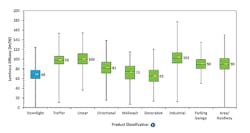DOE issues research on LED downlights and on OLED lighting
OLED lighting still holds potential, according to a US Department of Energy report on available products and promised improvements, while a Snapshot Caliper report on LED downlights reports lower levels of performance improvement relative to other SSL luminaire types.
The US Department of Energy (DOE) has released two different solid-state lighting (SSL) reports of late — one focused on OLED usage in architectural lighting and another on the state of LED-based downlight technology. "OLED lighting products: Capabilities, challenges, potential" looks at the performance delivered by current OLED performance and speculates on the potential for performance to challenge LED-based products. "Caliper snapshot downlights" laments the slow rate of performance advancements in LED downlights attributed in part to the easy target of compact fluorescent lamps (CFLs) used in many legacy downlight products.
Interested in articles & announcements on LED & OLED lighting reports?
The OLED report represents the middle in a series of three planned OLED projects to help gauge how well OLED panels may serve in architectural-grade lighting projects. We covered the first of the three projects back in May when the DOE released details of a Gateway demonstration project focused on OLED lighting of a small shared office. The third project will be an upcoming Caliper report that goes into detailed photometric testing and product teardowns of OLED lighting products.
The just-released report notes that OLED system efficacy is falling in the range of 21–44 lm/W. Clearly that level of performance trails widely quoted LED system efficacy that in many products is well beyond the 100-lm/W level. Still, it's important to consider like products when making a comparison and the most similar LED-based products from a functionality perspective would be a planar, LED-edge-lit product. The DOE report notes that a 4×4-in. LED-based panel from GLT is specified at 115 lm/W. LED panels also offer the advantage of scale in much larger panels from companies such as Eaton; Current, powered by GE; and Cree. Cree says its WaveMax-based planar 4-ft pendants deliver system efficacy up to 115 lm/W.
OLEDs also cost more and at this point are less reliable than LED-based products. Flicker is also an issue, although the DOE report notes that drivers optimized for OLED panels could eliminate the flicker problem and also improve efficacy — a conclusion also noted in the office OLED lighting Gateway report linked above.
Still, OLED is clearly intriguing to the DOE and the agency has continued to invest in OLED research and development as we noted in a recent story. The new report states that OLEDs still have the promise to be much thinner than LED-based planar products. Moreover, the potential exists for the use of flexible substrates that could enable many new application scenarios. Indeed, the DOE report mentions more than a dozen specific applications in which OLEDs could prove to be a viable option, but also generally as a complement to LED-based products and not fully replacing LED-based products.
You can download the complete report on the DOE website. The DOE will also hold a webcast on OLED technology on July 28.
Caliper on downlights
The Caliper Snapshot on downlights, conversely, discusses an application area in which LED source are quickly becoming dominant and displacing legacy CFL sources. Indeed, Philip Smallwood of our sister Strategies Unlimited business unit said at Strategies in Light (SIL) this year that price erosion had largely stopped in LED-based downlights because payback has reached one year — establishing what some in the industry have labeled Smallwood's Law.
The latest DOE report strikes a somewhat similar theme in that it says LED-based products are so superior from light control, efficacy, and lumen output perspectives that lighting manufactures are not focused on further improvement. Manufacturers' efforts on improving performance are generally focused more on luminaire products such as troffers where the incumbent linear fluorescent technology is relatively efficient and really cheap.
The real point is that there is tremendous room for improvements in downlights. Mean efficacy in the LED downlights that the DOE studied is only 68 lm/W. The mean in troffers is 98 lm/W and even the mean in directional lighting is 82 lm/W. Moreover, downlights have been on a slow pace to improve, gaining 8 lm/W in the past 20 months while LED luminaires in general are improving at the rate of 10 lm/W per year.
Still, the testing of LED downlight products in the market did yield some good news. The DOE said 38% offer CRI above 90. The DOE said the category generally exhibits better color fidelity than other types of SSL luminaires.
You can download the full Caliper Snapshot report from the DOE SSL website.

Maury Wright | Editor in Chief
Maury Wright is an electronics engineer turned technology journalist, who has focused specifically on the LED & Lighting industry for the past decade. Wright first wrote for LEDs Magazine as a contractor in 2010, and took over as Editor-in-Chief in 2012. He has broad experience in technology areas ranging from microprocessors to digital media to wireless networks that he gained over 30 years in the trade press. Wright has experience running global editorial operations, such as during his tenure as worldwide editorial director of EDN Magazine, and has been instrumental in launching publication websites going back to the earliest days of the Internet. Wright has won numerous industry awards, including multiple ASBPE national awards for B2B journalism excellence, and has received finalist recognition for LEDs Magazine in the FOLIO Eddie Awards. He received a BS in electrical engineering from Auburn University.





